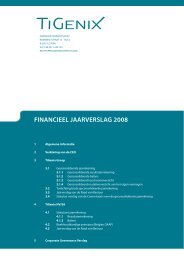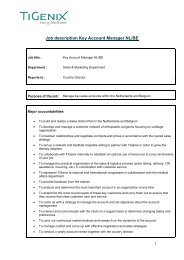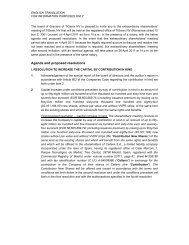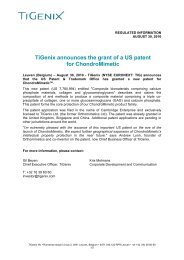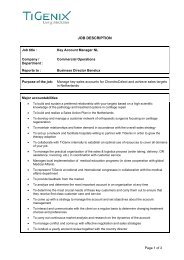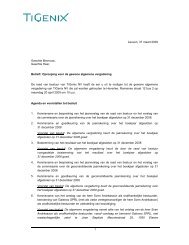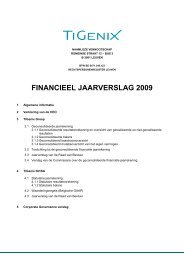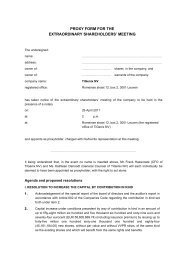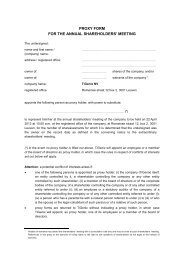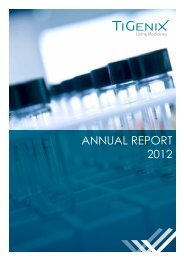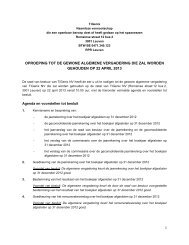ANNUAL FINANCIAL REPORT 2010 2010 - TiGenix
ANNUAL FINANCIAL REPORT 2010 2010 - TiGenix
ANNUAL FINANCIAL REPORT 2010 2010 - TiGenix
- No tags were found...
You also want an ePaper? Increase the reach of your titles
YUMPU automatically turns print PDFs into web optimized ePapers that Google loves.
Full thickness articular cartilage defectsArticular cartilage is a tough, elastic tissue that covers the endsof bones in joints and enables the bones to move smoothlyover one another. When articular cartilage is damaged throughinjury, it does not heal as rapidly or effectively as other tissues inthe body. Instead, the damage tends to spread, resulting in painand reduced mobility. Such symptoms can severely hinder aperson’s normal activities and occupation.As the natural healing capacity of damaged articular cartilage islimited, large full thickness cartilage injuries represent a primeopportunity for the application of Regenerative Medicine.When left untreated, cartilage injuries predispose the suffererto OA, which is a major cause of disability and represents asignificant socio-economic burden to society. Today, there isa belief amongst many medical professionals that repairingcartilage defects at an early stage can slow down or evenprevent progression to OA.Various surgical procedures are currently available for thelocal treatment of cartilage defects in the knee, includingdebridement and lavage, microfracture and osteochondralgrafting (also called mosaicplasty). However, none of thesesurgical treatments have been unequivocally proven to createfunctional and durable repair of cartilage in prospective,randomised clinical trials.The table below gives an overview of the most commonsurgical procedures used today, with a brief description oftheir main characteristics.Surgicalprocedure Description Main Characteristics Frequency of UseDebridementand lavageShaving of the edges, debridement of loosecartilage and lavage to remove loose tissuedebris.Easy, arthroscopic procedure, but norepair tissue formed.Most frequently used procedure forcartilage damage.Current use in the US is estimated at550,000 cases/yearMicrofracturePerforation of the subchondral bone plate tocreate a blood clot which, mixed with bonemarrow stem cells, tends to form a scar-likefibro-cartilaginous repair tissue.Easy arthroscopic procedure, but therepair tissue often is scar-like repairtissue, which, has not been associatedwith successful long-term clinicaloutcomes.Microfracture is considered today thestandard of care for smaller cartilagedefects up to 2-3 cm 2 .Current use (including abrasionarthroplasties) in the U.S. is estimatedat ca. 75,000 cases/yearOsteochondralgrafting(mosaicplasty)Osteochondral grafting is a technique inwhich one or more plugs of cartilage andbone are harvested from a lesser weightbearingarea in the joint and subsequentlytransplanted into the defect.Implants tend to give immediatemechanical support. Harvest site comorbidityis, however, very large andchances of failure are high.The use of osteochondral grafting islimited and decreasing.Current use in the U.S. is estimated tobe below 5,000 cases/yearAutologousChondroCyteImplantation(ACI)Implantation is a technique designed torepair articular cartilage by implanting thepatient’s own expanded cartilage cells.First a small cartilage biopsy is takenarthroscopically from a non-weightbearing area of the joint. The cells aresubsequently expanded in a specialisedcell culture facility and sent back tothe surgeon for re-implantation in thepatient. In conventional ACI, the cellsare implanted underneath a periostealflap, which has been harvested fromthe patient’s tibia and sewn onto thecartilage defect. Newer techniques usea biodegradable membrane or a matrixin which the cells are seeded.Autologous ChondroCyte Implantationhas been first used in the mid ‘80s.Most treatment algorithms recommendthe use of ACI in full thickness cartilagelesions larger than 2-3 cm².Current use in the US is estimated tobe around 1,500 patients per year.110 • <strong>TiGenix</strong> • Rights Offering



